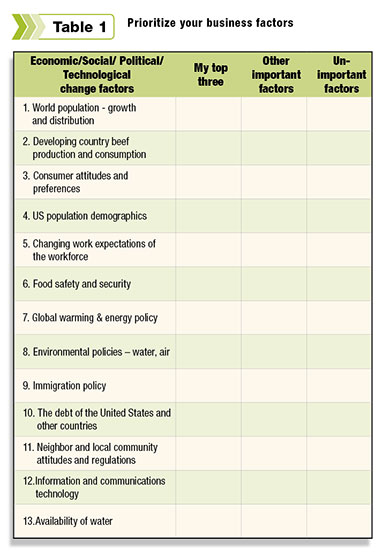The second owner has roles similar to the first manager with employees and processes. He, however, has an additional, perhaps even more important role.
Because his business does not have a specified menu and is in an ever-changing business environment, he must be continuously monitoring the changing menu item preferences of his customer, be aware of changes in competitors and neighboring businesses and be searching for new opportunities for and potential threats to his business.
Note that the second owner’s additional responsibility is more strategic and is more focused on the external environment.
This strategic leadership role is so crucial that a lapse here for even a short time could result in business failure.
The reason for comparing these two managers is that, until the past six to eight years, your role in the beef production business was very similar to the first manager.
Hard work, excellent management and a periodic, perhaps annual, strategic review was needed for success.
Today, however, your beef business is much more like the second business. At least one owner must be continuously aware of changes in the environment surrounding the farm – neighbors, regulations, labor markets, etc. – and be searching for new opportunities for and potential threats to the business.
Your new and likely most important role is strategic leadership of your dairy farm business.
To address this issue, we look at three topics:
- The required mind-set change
- The external business environment
- Addressing opportunities and threats
The required mind-set change.
Think about the following:
- Montgomery Ward, Kmart, JC Penney and Sears have disappeared or struggled because they did not see the changing world as clearly as did Walmart and Target.
- General Motors, Chrysler and Ford have struggled for decades because they lagged Toyota and Honda in changing strategy to meet the changing preferences of drivers and failed to adopted quality assurance techniques in their factories.
- Polaroid disappeared and Kodak has struggled as they lagged in responding to the digital age.
All three feature failures in strategic leadership. Walmart, Target, Toyota, Honda and the new digital image companies did not have any knowledge that was not available to Montgomery Ward, Kmart, JC Penney, Sears, General Motors, Chrysler, Ford, Polaroid and Kodak.
Rather they had superior strategic leadership to recognize changes in their environment and proactively develop strategies to capitalize on the changes.
The importance of strategic leadership is not limited to large corporations. In today’s turbulent world, it may be even more important to small businesses like your beef business.
Successful strategic leadership means making strategic adjustment while you are successful in your current strategy.
Strategic changes are less likely to succeed when they are implemented after the business is already financially stressed.
Successful strategic leadership is continuous and proactive. The speed and urgency of today’s agricultural and business environment requires that you make strategic leadership your number one priority.
I like to say: “At least one owner needs to roll out of bed in the morning thinking about the future of the farm business.” The animals and crops are crucial but they cannot always be top priority.
The external business environment
Successful strategic leaders of big companies – Walmart, Target, Toyota, Honda – and of small businesses like yours continually observe and seek to understand the environment in which their business is operating.
Producers like you have become much more proficient at monitoring one key external element – output and input prices.

The external factors impacting your business, however, reach far beyond prices.
Table 1 gives an incomplete list of the factors that may impact your ranch or farm in the next 10 to 20 years.
Table 1 also provides you an opportunity to assess the importance to your business of these factors.
You should select the three that you think will be most important and then, for each of the remaining factors, decide whether it will be important or unimportant.
Addressing opportunities and threats
Scenario planning is an incredibly valuable tool for addressing opportunities and threats.
It is a process of creating possible future plans for unlikely but major eventualities that can impart your beef business.
A scenario plan is not a detailed plan; it allows for initial thinking in a crisis-free setting and provides an initial starting point should the eventuality occur.
The following are some threats that a scenario plan could better position you to address: a large workforce defection, an extreme weather event (tornado, hurricane, etc.), anything requiring quarantine of animals, death or disability of an owner, a manure spill endangering surrounding water/land/people, bankruptcy of a business supplier/partner (example: MF Global).
An example of a scenario plan for an opportunity is: The owner of a farm in your area knocks on your door. He is nearly in tears and says: “My creditors have given me until tomorrow to commence serious negotiations for the sale of my ranch or liquidation will begin. Are you interested?”
A concluding question
How will you know when you have acquired the mindset of a strategic leader. Let me suggest two ways:
1. Your thinking will be different. When your mind is processing ideas – one of my clients calls it “noodling” – you will be thinking about more than animals and crops.
You will be thinking about opportunities and threats to your business and how to prepare for and/or address them.
2. Your professional growth plan will include strategic leadership growth opportunities:
- Joining a leadership organization: Chamber of Commerce or a local community service organization (Rotary, Lions, etc.) or a Baldrige awarding quality organization.
- Reading books on leadership or e-newsletter like those from Harvard Business or LearningEdge Monthly (my e-newsletter).








